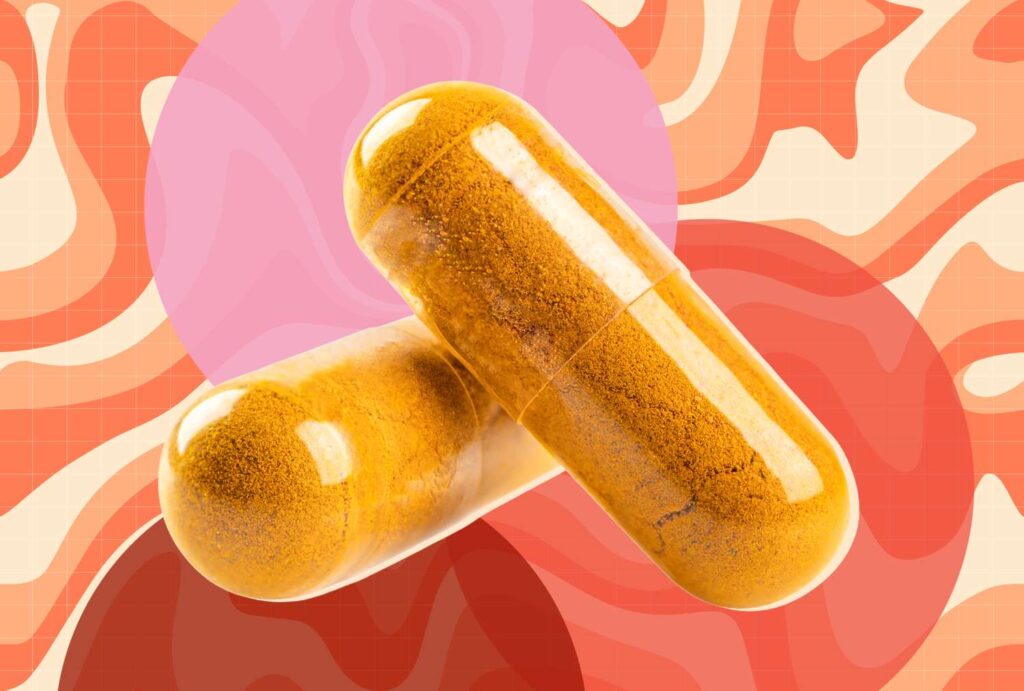- Pair turmeric with black pepper and fat to help your body absorb its healthy compound.
- Too much turmeric can harm your liver or cause stomach issues—use food sources or safe doses.
- Pick independently verified supplements and check with a provider before adding turmeric.
From golden lattes to wellness shots, turmeric has become a popular supplement and a celebrated super spice in the wellness world. This bright yellow spice has been used for centuries in Ayurveda and Chinese medicine, and recent research is now backing up its many health benefits. “Turmeric is a bright yellow spice best known for its active compound, curcumin, which has powerful anti-inflammatory and antioxidant properties,” says Katie Schimmelpfenning, RD. Traditionally used in Indian and Southeast Asian cuisines, turmeric is now found in everything from smoothies to wellness drinks and capsules, promising benefits for inflammation, oxidative stress and overall health.
However, getting the most out of turmeric isn’t as simple as sprinkling it on your food or popping a capsule. Curcumin is notoriously difficult for the body to absorb, and dietitians caution that several common mistakes can make your efforts less effective—or even unsafe. Here are the most common mistakes to avoid when taking turmeric so you can enjoy its potential benefits.
1. Not Pairing Turmeric with Black Pepper
The biggest challenge with turmeric is that its key compound, curcumin, is hard for the body to absorb on its own. “Turmeric’s active compound, curcumin, has poor bioavailability, but pairing it with piperine from black pepper can boost absorption,” says Schimmelpfenning.
Piperine helps slow down the metabolism of curcumin in the intestine and liver, which helps your body absorb more of the active compound. Some studies have found that combining the two can result in up to a 2,000% increase in curcumin absorption.
If you’re taking a turmeric supplement, look for one that has piperine added. When cooking, use black pepper and turmeric together to help your body make the most of this powerful spice.
2. Using Turmeric Without Fat
Even with black pepper, you’re still missing a key piece of the absorption puzzle if you’re not pairing turmeric with a source of fat. “Curcumin is fat-soluble, meaning it’s best absorbed when consumed with a source of fat like olive oil, avocado, coconut milk or nuts,” says Schimmelpfenning. Without a fat source, much of the curcumin will simply pass through your system unabsorbed and unused.
Eating turmeric with a fat-containing meal increases the amount of curcumin absorbed during digestion, so some supplement manufacturers adjust their formulations to add lipids (simple fat molecules) for a similar effect. When it comes to planning your meals around flavor and health, Schimmelpfenning recommends adding turmeric and black pepper to curries made with coconut milk for maximum bioavailability and deliciousness.
3. Taking Too Much Turmeric
Too much of a good thing can be a very bad thing, especially when it comes to supplements. “Just because it’s ‘natural’ doesn’t mean it can’t be harmful,” says Alexandria Hardy, RDN, LDN, emphasizing that too much turmeric can be dangerous to liver health. You’re not at risk of overdoing it on turmeric when it’s eaten as part of your diet, but high-dose turmeric supplements could cause symptoms as severe as liver failure, in some rare cases.
While the World Health Organization recommends an adequate daily intake of 1.4 milligrams of turmeric per pound of body weight (about 210 milligrams for a 150-pound adult), some studies have found doses up to 8 grams per day to be safe, while many clinical studies have found potential benefits with a wide range of doses between the two.
Aside from the rare case of liver failure, turmeric can have other, more common side effects if too much is taken. “High doses can interact with medications and cause gastrointestinal distress, so food sources or moderate supplementation are usually safest,” says Schimmelpfenning.
4. Choosing the Wrong Supplement
You’ll find dozens of turmeric supplements to choose from on any health food shelf, and even more online. Beyond the various formulations and doses, the quality, purity and potency itself are largely up to the manufacturer. This makes it difficult to know whether you’re choosing a product that actually contains what the label claims and that it’s free from harmful substances like heavy metals or other contaminants.
Inaccuracy in labeling is more common than you might realize. A 2022 case study found that only 4 out of 14 turmeric supplements tested had accurate labeling. Choosing a supplement that has been independently verified with certifications like USP, NSF or Informed Choice can give you peace of mind that the product label is accurate.
To improve the odds that your body can absorb the active ingredient, look for supplements that enhance bioavailability with the addition of piperine, the trademarked formulas Theracumin, BCM-95 or Meriva, or a nanocurcumin formulation, all of which current research has found to be the most bioavailable and effective options.
5. Not Checking for Medication Interactions
Medication interactions are not reserved for prescribed medications or over-the-counter drugs. Even supplements like turmeric can have serious side effects when mixed with the wrong things. Hardy warns anyone who takes prescribed medications, especially heart meds or antidepressants, to check with their health care provider or pharmacist before taking a turmeric supplement, as it can reduce the effectiveness of these medications, leading to potentially dangerous consequences.
Our Expert Take
Turmeric can be a powerful spice and supplement, but only when it’s used correctly. Dietitians recommend pairing turmeric with black pepper and a fat source to help your body better absorb and benefit from its anti-inflammatory and antioxidant effects. Before taking a turmeric supplement, check with a health care provider. This can help you avoid any dangerous medication interactions. And make sure to purchase your supplement from a reputable company that participates in third-party testing.

